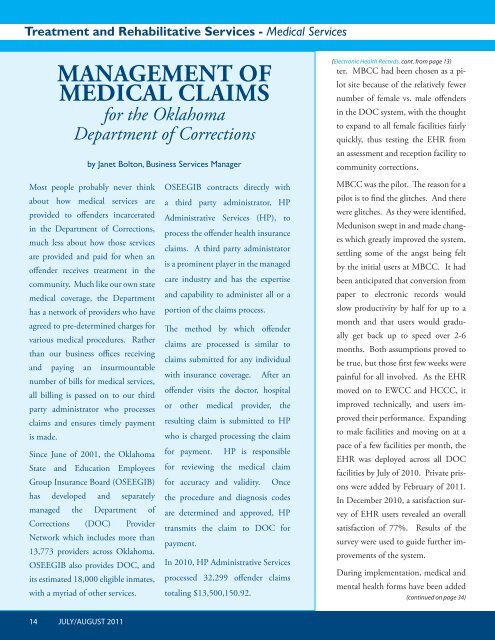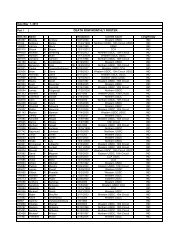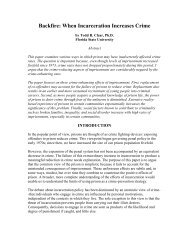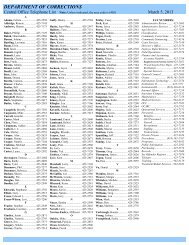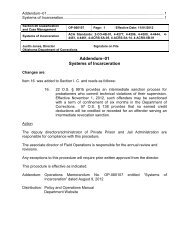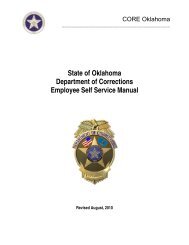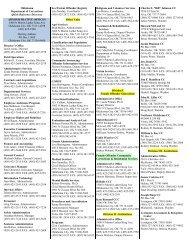Programs, Mental Health, Medical & Education - Oklahoma ...
Programs, Mental Health, Medical & Education - Oklahoma ...
Programs, Mental Health, Medical & Education - Oklahoma ...
You also want an ePaper? Increase the reach of your titles
YUMPU automatically turns print PDFs into web optimized ePapers that Google loves.
Treatment and Rehabilitative Services - <strong>Medical</strong> Services<br />
Most people probably never think<br />
about how medical services are<br />
provided to offenders incarcerated<br />
in the Department of Corrections,<br />
much less about how those services<br />
are provided and paid for when an<br />
offender receives treatment in the<br />
community. Much like our own state<br />
medical coverage, the Department<br />
has a network of providers who have<br />
agreed to pre-determined charges for<br />
various medical procedures. Rather<br />
than our business offices receiving<br />
and paying an insurmountable<br />
number of bills for medical services,<br />
all billing is passed on to our third<br />
party administrator who processes<br />
claims and ensures timely payment<br />
is made.<br />
MANAGEMENT OF<br />
MEDICAL CLAIMS<br />
for the <strong>Oklahoma</strong><br />
Department of Corrections<br />
Since June of 2001, the <strong>Oklahoma</strong><br />
State and <strong>Education</strong> Employees<br />
Group Insurance Board (OSEEGIB)<br />
has developed and separately<br />
managed the Department of<br />
Corrections (DOC) Provider<br />
Network which includes more than<br />
13,773 providers across <strong>Oklahoma</strong>.<br />
OSEEGIB also provides DOC, and<br />
its estimated 18,000 eligible inmates,<br />
with a myriad of other services.<br />
14 JULY/AUGUST 2011<br />
by Janet Bolton, Business Services Manager<br />
OSEEGIB contracts directly with<br />
a third party administrator, HP<br />
Administrative Services (HP), to<br />
process the offender health insurance<br />
claims. A third party administrator<br />
is a prominent player in the managed<br />
care industry and has the expertise<br />
and capability to administer all or a<br />
portion of the claims process.<br />
The method by which offender<br />
claims are processed is similar to<br />
claims submitted for any individual<br />
with insurance coverage. After an<br />
offender visits the doctor, hospital<br />
or other medical provider, the<br />
resulting claim is submitted to HP<br />
who is charged processing the claim<br />
for payment. HP is responsible<br />
for reviewing the medical claim<br />
for accuracy and validity. Once<br />
the procedure and diagnosis codes<br />
are determined and approved, HP<br />
transmits the claim to DOC for<br />
payment.<br />
In 2010, HP Administrative Services<br />
processed 32,299 offender claims<br />
totaling $13,500,150.92.<br />
(Electronic <strong>Health</strong> Records, cont. from page 13)<br />
ter. MBCC had been chosen as a pi-<br />
lot site because of the relatively fewer<br />
number of female vs. male offenders<br />
in the DOC system, with the thought<br />
to expand to all female facilities fairly<br />
quickly, thus testing the EHR from<br />
an assessment and reception facility to<br />
community corrections.<br />
MBCC was the pilot. The reason for a<br />
pilot is to find the glitches. And there<br />
were glitches. As they were identified,<br />
Medunison swept in and made chang-<br />
es which greatly improved the system,<br />
settling some of the angst being felt<br />
by the initial users at MBCC. It had<br />
been anticipated that conversion from<br />
paper to electronic records would<br />
slow productivity by half for up to a<br />
month and that users would gradu-<br />
ally get back up to speed over 2-6<br />
months. Both assumptions proved to<br />
be true, but those first few weeks were<br />
painful for all involved. As the EHR<br />
moved on to EWCC and HCCC, it<br />
improved technically, and users im-<br />
proved their performance. Expanding<br />
to male facilities and moving on at a<br />
pace of a few facilities per month, the<br />
EHR was deployed across all DOC<br />
facilities by July of 2010. Private pris-<br />
ons were added by February of 2011.<br />
In December 2010, a satisfaction sur-<br />
vey of EHR users revealed an overall<br />
satisfaction of 77%. Results of the<br />
survey were used to guide further im-<br />
provements of the system.<br />
During implementation, medical and<br />
mental health forms have been added<br />
(continued on page 34)


